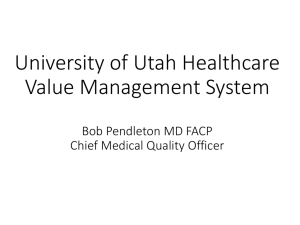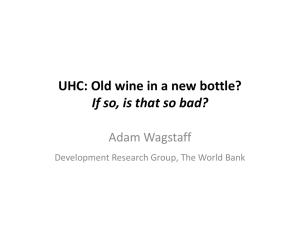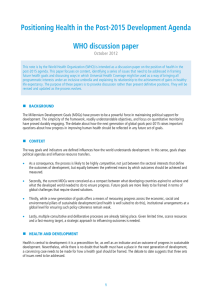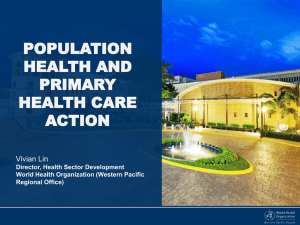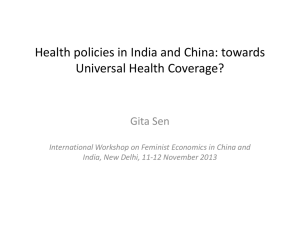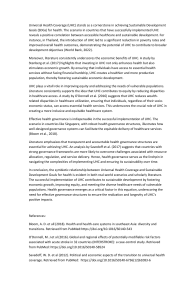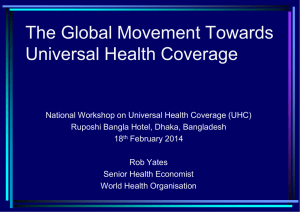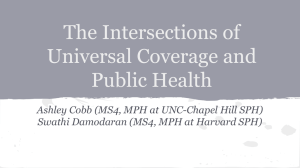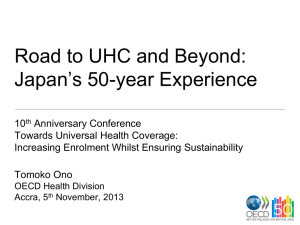Universal Health Coverage - Concept and Vision for India
advertisement
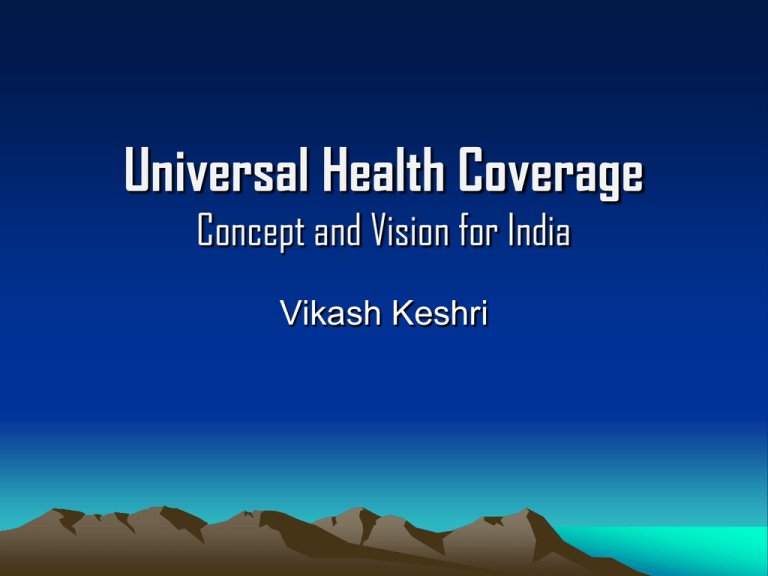
Universal Health Coverage Concept and Vision for India Vikash Keshri UHC: What? “Ensuring that all people have access to needed Promotive, preventive, curative and rehabilitative health services, of sufficient quality to be effective, while also ensuring that the use of these services does not expose the user to financial hardship”. World Health Organization “ Ensuring equitable access for all Indian citizens, resident in any part of the country, regardless of income level, social status, gender, caste or religion, to affordable, accountable, appropriate health services of assured quality (Promotive, preventive, curative and rehabilitative) as well as public health services addressing the wider determinants of health delivered to individuals and populations, with the government being the guarantor and enabler, although not necessarily the only provider, of health and related services”. HLEG on UHC, Planning Commission. Historical Perspectives: • 1883 Health Insurance Bill, Germany became the first country to make nationwide health insurance mandatory • In U. K. Enactment of the National Insurance Act in 1911 and the National Health Service (NHS) in 1948. which caters to all legal residents of Great Britain. • Article 25.1 of the 1948 Universal Declaration of Human Rights states right to health as an important fundamental right. • 1966, The International Convention on Economic, Social and Cultural Rights recognized "the right of everyone to the enjoyment of the highest attainable standard of physical and mental health. • 1978: Alma-Ata declaration & the vision of "health for all.“ • World Health Assembly adopted the term 'Universal Health Coverage' in 2005, • WHO Definition: Three objectives: Equity in access to health services. Quality of health services. Financial-risk protection. • WHO: Constitution of 1948 Declaring health a fundamental human right and on the Health for All agenda set by the Alma-Ata declaration in 1978. Achieving the health Millennium Development Goals and the next wave of targets looking beyond 2015 will depend largely on how countries succeed in moving towards universal coverage Three Dimensions for UHC 10 Facts: 1. Universal coverage ensures that all people can use health services without financial hardship. 2. All people should have access to the health services they need. 3. Out-of-pocket payments push 100 million people into poverty every year. 4. The most effective way to provide universal coverage is to share the costs across the population. 5. All countries are continually seeking more funds for health care. 6. In 2010, 79 countries devoted less than 10% of government expenditure to health. 7. Countries are finding innovative ways to raise revenue for health. 8. Only eight of the world’s 49 poorest countries have any chance of financing a set of basic services with their own domestic resources by 2015. 9. Globally, 20–40% of resources spent on health are wasted. 10. All countries can do more in order to move towards universal coverage Current Scenario: A Global Movement towards UHC • 50 countries have attained universal or near universal coverage • Asia, Africa and the Middle East. • 2010 World Health Report builds upon the 2005 WHA recommendations: Highlights three basic requirements of universal health care: Raising sufficient resources for health Reducing financial risks and barriers to care, Increasing efficient use of resources • 2010 World Health Report : Recommendations Cont…… • To generate adequate funds, – Spurs high-income countries to "honour their commitments" to international aid . – low-income countries "increase the efficiency of revenue collection, reprioritize government budgets, [and introduce] innovative financing" to increase domestically available funds. – financing that makes health care accessible to all. • Subsidy to Poor. • Compulsory contribution Alternative to free for service. Vision for UHC: HLEG Contextualizing UHC in INDIA. • Considerable Progress in Public Health. • NRHM : Many states significant development. • Progress not as desired. • Health system: – Responsible for sluggish progress on key health indicators and outcomes. – Poor financing, governance and management. • Health Financing: Several Forms exist but mostly OOP. • Only 1/4th population covered by some Insurance. • The current programmes not adequate for achieving UHC. • Lack of efficient public system encourages Private system to flourish. • Wide variations b/w states: – Tamil Nadu and Kerala Model system – EAG states – Probability of dying within 1st birthday 6 times more in M. P. compared to Kerala. – Life expectancy in M. P. 56 compared to 74 in Kerala. • UHC in India: Flexible approach for regions. – Rural Vs. Urban: 43 % Malnutrition in rural Vs. 49% Obesity in urban children. – 42% of doctors in rural area has no formal training. Guiding Principles: 1. Universality, 2. Equity, 1. Equity in access to services and benefits: 2. Equity ensured by special measures to ensure coverage of sections with special needs: 3. Non-exclusion and non-discrimination, 4. Comprehensive care that is rational and of good quality, 5. Financial protection, 1. Equity in financing: 2. Cashless Financing 6. Protection of patients' rights that guarantee appropriateness of care, 7. Patient choice 8. Portability and continuity of care, 9. Consolidated and strengthened public health provisioning, 10. Accountability and transparency, 11. Community participation and 12. Putting health in People’s hands. Two critical factors to achieve and sustain UHC: • Social determinants of health and • Gender Issues Envisioning the Future: Seeking Stability and Health Protection in the Midst of Multiple Transitions • • • • • Demographic transition. Epidemiological and Nutritional Transitions. Managerial transitions Political transition. federal nature of India's polity In conceptualizing a UHC system, a focus on India's future will be crucial to ensure the implemented system is able to exist in, make the best of and respond to the country's changing demographic, health, political and economic scenario. Health Beyond Health Care: Addressing the Broader Determinants of Health Social Determinants of Health: “The conditions in which people are born, grow, live, work and age, including the health system“ 2008 Report, CSDH. Gender as a Determinant of Health Positive Externalities of Health and Universal Health Coverage • Benefits of Improvement in Health of Population. • Strengthened Primary system reduce load on secondary and tertiary system: Economic Implications. • Employment Opportunity : To strengthen Health System. Areas of Convergence and Consensus: for charting India’s Path to UHC: Technical, managerial and political barriers Conclusions: • Constitutionally committed to improve public health (Directive Principle 42). • Several supreme court judgments directs right to health as extension of fundamental right. • GOI signatory to international conventions that obligate it to ensure the Right to Health. • Organizing and Operationalizing Universal Health Coverage in India is an urgent necessity. • Evidence demonstrate that health care systems with universal coverage address economic inequality. • This fundamental right that can be eventually achieved only by strengthening health services and addressing the social determinants of health, including food security and nutrition, water supply, sanitation and living conditions
